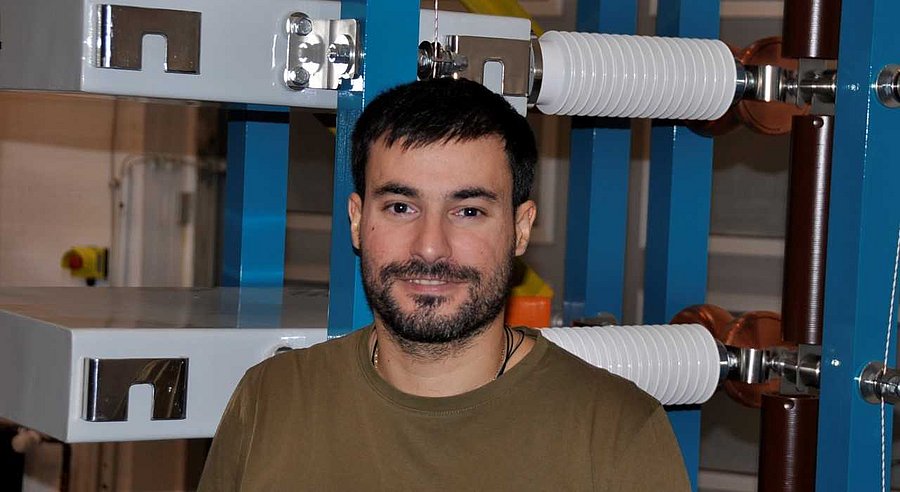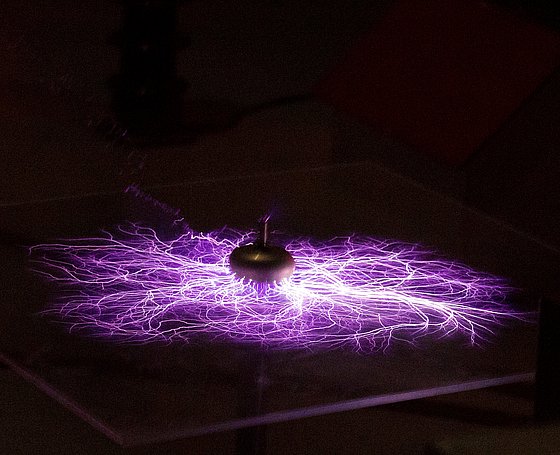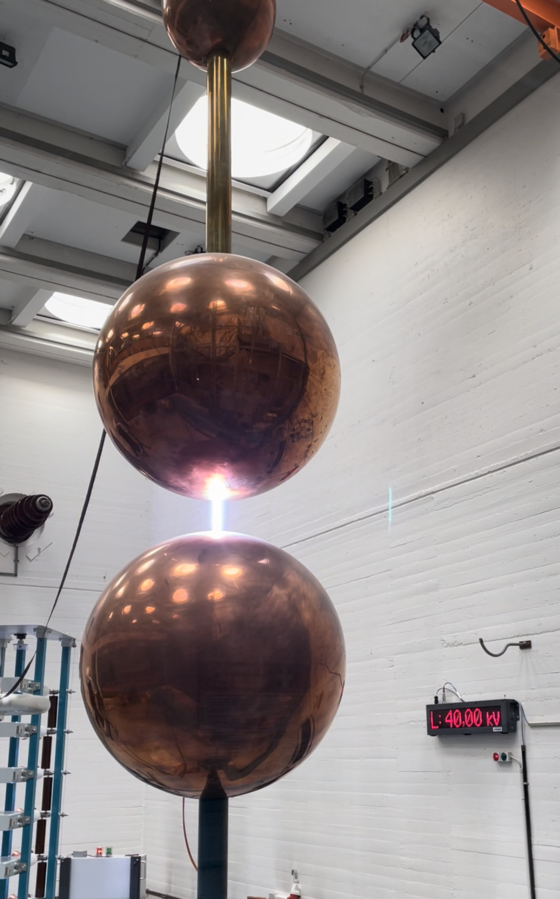
High voltage transformers
Dr.-Ing. Petros Dalamaras / Electrical Power Supply Engineering
Photo: UniService Transfer
Germany occupies a top international position in power supply reliability
Dr.-Ing. Petros Dalamaras and his colleague Niklas Schmidt at the Chair of Electrical Power Supply Engineering, Condition Assessment and Asset Management Research Group, are researching the aging behavior of high-voltage transformers.
High-voltage transformers are responsible, among other things, for supplying entire city districts, including Wuppertal. The existing age structure presents network operators with fundamental tasks. High-voltage transformers have an average age of around 40 years (worldwide), which represents a major challenge in maintaining supply reliability. In the AHtra research project (Aging Behavior of High Voltage Transformers), engineer Dr. Petros Dalamaras and his colleague Niklas Schmidt at the Chair of Electrical Power Supply Engineering of Prof. Dr.-Ing. Markus Zdrallek are dealing with the challenges facing the grids due to the energy transition. The scientist categorically denies the question whether the grid operators have missed the development in this context. "The grid operators have done a very good job so far and continue to do so very conscientiously," Dalamaras states the current state of affairs and emphasizes: "Germany occupies a top position internationally in terms of the reliability of the power supply." On the contrary, the high-voltage transformers showed no extreme susceptibility to faults and had very low failure probabilities. "Statistically, a high-voltage transformer like this fails every 100 years." Certainly, the transformers had already reached a certain age, and therefore the AHtra project was also important so that nothing would be missed in the future, "but the conditions of the high-voltage transformers in the DACH region (DACH region means the area of Germany, Austria and Switzerland, editor's note) show a very high level and offer no cause for concern." In this context, Wuppertal's municipal utilities have been project partners of the university for many years and are involved in several research projects. "We know and appreciate each other very much, which is why we are very happy to discuss new and innovative project ideas with WSW on a frequent basis," Dalamaras explains.
Impact of the energy transition on supply reliability
The aim of the project is to guarantee today's high level of supply reliability in the future as well. Says Dalamaras: "In a global comparison, in terms of average power interruption duration, we are in a very good position. In figures: 10.2 minutes in 2020 in Germany, 92 minutes in the USA. Thus, for now, we can say: don't panic!" At the chair, the researcher and his colleagues are working intensively on the challenges facing the grids as a result of the energy transition, as well as on the effects of the energy transition on supply reliability. "In terms of costs and implementation, the energy transition is placing an enormous burden on grid operators," he says, adding that there is a high need for expansion and that energy flows are becoming increasingly complex as well. For this reason, the Chair of Electrical Power Supply Engineering is developing innovative concepts together with research partners - commercial and industrial companies as well as grid operators - to meet these challenges.
Findings on aging behavior are valid
"Within the framework of this research project, we were able to create an extensive database for the first time together with our 37 project partners," explains the researcher. "Among other things, we have currently been able to read in around 60,000 oil reports from over 3,500 high-voltage transformers into the database. This allows us to perform extensive analyses and make valid statements about aging behavior." His team has also already been able to draw initial preliminary conclusions from the available data. "We see that, in general, the high-voltage transformers in the DACH region are in good condition. Likewise, we see that the condition of high-voltage transformers tends to deteriorate linearly over age. The much-cited bathtub curve could not be found so far." (The bathtub curve describes the failure frequency as a function of the age of the equipment and resembles the cross-section of a bathtub, editor's note).

Corona discharges on plexiglass plate
Renewal strategies, costs and trust
Efficien maintenance is one side of the coin, but a renewal strategy is also becoming increasingly important. The scientist describes what this might look like: "The network operators regularly carry out oil analyses to determine the current condition of the high-voltage transformers. Depending on the aging effect and condition of the high-voltage transformer's oil, there is the possibility of oil renewal to extend the service life by up to 10 years. This is a combination of maintenance and renewal." In addition, another option is referred to in the industry as retrofit, Dalamaras explains. This involves bringing the high-voltage transformer back up to speed in a workshop, but at a higher cost. "The problem of rising costs is already being felt by many grid operators. For this reason, knowledge about the actual condition of the high-voltage transformers as well as the actual aging behavior plays an enormously important role," the scientist knows, and this is always taken into account when making optimal decisions. The cooperation with the various project partners, he says, is based primarily on a trusting relationship due to long-standing and successful collaborations. "Therefore, on the one hand, the data recorded by the project partners are made available to us for further processing and analysis, and on the other hand, it is also possible for us to recommend additional measurements and then help carry them out." Meanwhile, the chair has a wealth of experience from the use of various measurement and testing methods in the university's own high-voltage laboratory as well as from on-site investigations, which can be carried out with the help of a cable measurement truck, among other things.

Flashover at ball spark gap
The high voltage laboratory
Many experiments take place in the department's high-voltage laboratory, which is open to children and also adults at certain times. Whether on the open day as part of the 50th anniversary of the University of Wuppertal or the program with the mouse day carried out by WDR, Dalamaras and his colleagues like to show how to measure current and voltage. "On Mouse Day, for example, the children were able to use a thermographic camera to find out which of the cables shown had electricity flowing through them, because you can't see it. We like to use days like this to show people our work and get the younger generation curious about getting interested in electrical engineering." Most of the time, however, the high-voltage lab is used for experiments, he said. Various public projects, most of which are funded over three years, as well as individual requests from grid operators, make various investigations necessary. "For example, grid operators send us medium-voltage cable sections as part of another research project, and we then try to determine the condition of the cables over several examinations to see what condition a 20-year-old cable is in and what condition a 50-year-old cable is in," Dalamaras says. It's the same with other operating equipment, such as local substations, he adds. "You know these stations, they are such small buildings that you see along the roads and they supply electricity to the surrounding houses. We have about 600,000 local network stations in Germany. Network operators are thus in a permanent search for optimization opportunities, with targeted, long-term maintenance and renewal planning becoming their focus."
Valuation methods
Valuation methods are often handled differently in the companies. "The question that often comes up is not whether a deterioration of condition can be determined or whether a deficiency exists, but how critical this deterioration of condition or deficiency is to be assessed," Dalamaras says. The chair is therefore striving for standardization for better understanding. The engineer describes what this might look like as follows: "The numerous findings and experiences on realistic condition assessment from previous research projects are used to enable a standardization of the different assessment results. In the process, we conduct individual workshops with the project partners, introduce uniform assessment principles, etc., in order to ultimately objectify the condition assessment."
Targeted future models
Findings developed in science are often slow to be implemented in business. But in the energy industry, all stakeholders are now pulling in the same direction. "Nowadays," says Dalamaras, "commercial enterprises are aware of the fundamental challenges they face - such as now here in our case, among other things, the existing age structure as well as the advancing aging of the operating resources used in the networks." Thus, the chair is trying to develop new approaches together with industrial companies, network operators as well as other research institutions in order to cope with the individual challenges in a target-oriented way. "The creation of assessment systematics as well as the development of aging models for network assets has been a central part of the work of our research group 'Condition Assessment and Asset Management` for many years," he concludes. "With very great success, assessment systematics for medium-voltage grid stations and cable systems, gas-insulated high-voltage switchgear, and high-voltage transformers have already been developed in several research projects together with numerous grid operators and partners from industry."
Research acceptance always has to do with understanding. The high-voltage laboratory of the University of Wuppertal therefore offers guided tours every now and then to explain to citizens how voltages are measured and experiments are carried out to ensure the quality and safety of electrical voltages.
Uwe Blass
Dr.-Ing. Petros Dalamaras is head of the research group "Condition Assessment and Asset Management" at the Chair of Electrical Power Supply Engineering.
